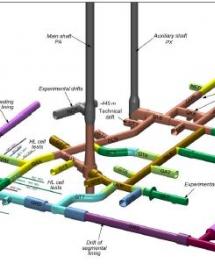Synthesis of 20 years Research, Development and Demonstration in Andra's Underground Research Laboratory in Bure for Cigéo
Since 1991 and its creation, Andra has been carrying out the research linked to the management of high
level (HA - HLW) and intermediate level long lived (MA-VL – ILLW)) radioactive waste in France. The French
Deep Geological Repository (DGR) project is called “Cigéo” project (Centre Industriel de stockage
GEOlogique).
Since 2000, the project for the development of Cigéo has been supported by a research and development
(R&D) programme that included the construction and operation of an Underground Research Laboratory
(URL) in a deep clay formation (Callovo-Oxfordian) as host rock. Prior to that, the clay formation was
recognized via surface investigations (seismic survey…) and boreholes. The knowledge acquired step by
step by Andra while operating the URL has been used to develop progressively the Cigéo project in link
with the major milestones.
The synthesis report brings you a detailed perspective of the R&D programme that was conducted in the URL.
Read or download the research synthesis document here
Prior to the construction and later during the operation of the URL, geoscientific research programmes
have been carried out to provide data for regional geological and hydrogeological modelling. More than
fifty deep geological boreholes have been drilled. Most of them were cored and tested and logged.
From 2004 to 2019, 1700 m of scientific and technical drifts up to 9 m in diameter were excavated in
the URL (Figure 4). Four technical excavation means have been used (drill and blast, pneumatic hammer,
road header, and tunnel boring machine with segment erectors). Many techniques for lining and
supporting the drift walls have also been tested (steel arches, bolts, shotcrete with or without
reinforcement, and segments).
These drifts have three main purposes (i) circulation and access to experimental and technical zones, (ii)
technical areas (safety niches, power supply niche, cement preparation niche), and (iii) experimental
zones.
The main level of the URL is implemented in the middle of the Callovo-Oxfordian formation where the
clay content is at is maximum (55%). This level is also the level defined for the waste disposal vaults. In
the URL, the drift at 455m aimed at starting the experiment programme in the upper part of the layer
and allow the setting up of the REP experiment dealing with the host rock behaviour during shaft
excavation.
More than 850 boreholes have been drilled from the drifts providing 8000 m of core for geological survey
and laboratory analysis (58,000 samples). More than 10,000 sensors are monitored in real time on an
integrated data acquisition and management system (SAGD/DAS). The system displays and holds records
of all of the data acquired since the experimental drifts were put into service. It is also used for
monitoring the environmental parameters that may influence the phenomena observed (temperature,
hygrometry, effects of excavation in adjacent drifts, etc.).
Looking back over more than 25 years of URL construction and operation, three main phases can be
defined in close relation with the milestones of Cigéo project development plan. The first one that took
place from 2000 to 2005 is the confirmation of the intrinsic favourable properties of the Callovo-
Oxfordian clay to demonstrate the feasibility principal of Cigéo project, in particular for long term safety.
The second one from 2006 to 2010 was mainly focused on the deeper characterization of the disturbance
that would be generated by the repository on the Callovo-Oxfordian and the behaviour of engineering
components (steel, concrete, glass…). The third one from 2010 to 2015 consisted of firstly testing
construction and operation options in order to design a reversible repository that could be safely closed
and sealed at the end of a century long period of operation.
The current phase started in 2016 aims at providing additional scientific and technical evidence to
support the license application of Cigéo project, including its instruction.
This report proposes an overview of these 25 years of French URL development. It will present the drivers
of the scientific and technological R&D programmes and how these programmes were up-dated and set
up to accompany the development of Cigéo project. To illustrate the purpose of the report, the four R&D
investigation phases of the URL are described with selected example R&D key experiments designed,
implemented and performed.


